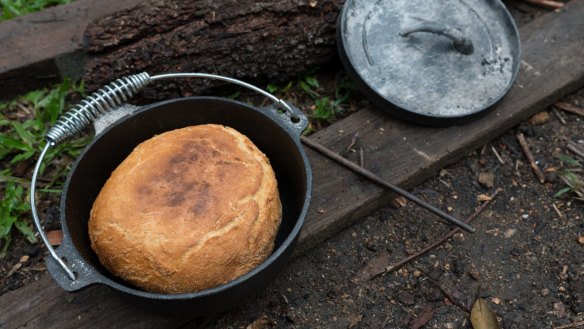How to make light and fluffy damper

My damper is tough and heavy. P. Riordan
Before the beginning of the 19th century, "damper" was something found inside pianos to quieten the sound or in chimney flues to slow the airflow. Then the word damper was first used to describe bread made without yeast in the early 1800s in Australia. It referred to dough cooked in the coals or ashes of a fire. Lancashire migrants and convicts may have loaned their word "damper", something that dampens the appetite, to a style of making bread in Australia that extends back tens of thousands of years. Indigenous people have long ground grains and seeds to make flour for a dough cooked in the ashes of a fire. (In East Gippsland, the people of the Gunai Kurnai even made damper with ground, native truffles the size of small footballs.) With colonisation, the cook-in-the-fire concept remained, but the native ingredients were exchanged for flour. Now when making damper with flour, the secret is not to overwork the dough. The idea is to bring the water and self-raising flour together to form a rough dough but do not knead it. This will form long strands of gluten in the dough that will make it hard and tough. When making bread, the effects of yeast and time allow the gluten to relax and break down the starch and protein. Damper uses neither yeast nor time. The secret to enjoying damper is to eat it while it's still warm, with lashings of butter or to dip it into the gravy of a slow-cooked stew (see below).
When I cook meals in the slow cooker, they are too watery and lack flavour. K. McKinnon
I once planned a long winter weekend away with loads of red wine and some excellent food, including a delicious dish of slow-cooked oyster blade redolent of bay leaves and dotted with my own olives. Except I left the stew in the slow cooker. All weekend. When I returned three days later, almost all of the stock and red wine had nearly all evaporated, and the contents turned into a rich sticky mess. And it was delicious. The best slow-cooker stew ever. Slow cooking takes place around 75C. Many slow cookers can't reach high temperatures to fry off the meat and vegetables to brown them. This browning combines protein and carbohydrates to create new tasty compounds and is called the Maillard reaction. If you want really yummy slow-cooked food, make sure meat and veg are well browned in a heavy-based metal pan before you add them to the slow cooker. (Some slow cookers now have a browning function.) If you find, at the end of the cooking time, that the meat and vegetables are tender but there is too much liquid, you can reduce the liquid by pouring it off and cooking it down in a pot on the stove until the desired consistency is reached. It can then be returned to the slow cooker and mixed through the other ingredients before serving.
Send your vexing culinary conundrums to brainfood@richardcornish.com.au or tweet to @realbrainfood.
Appears in these collections
- More:
- Food
- Brain food
